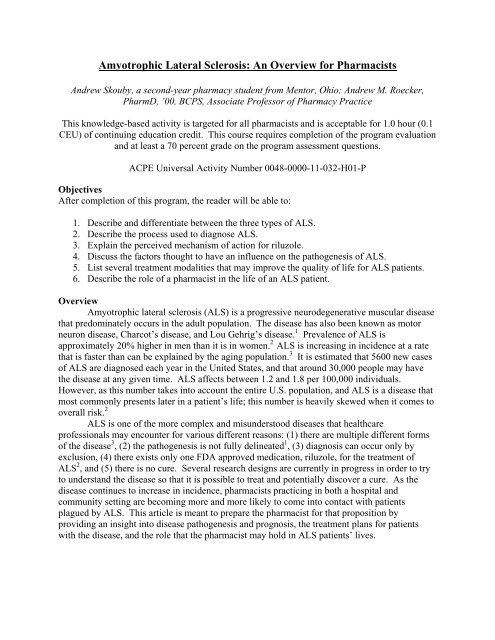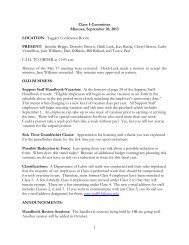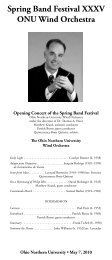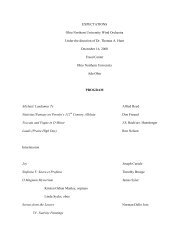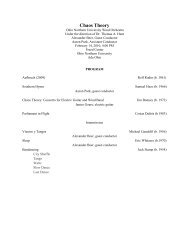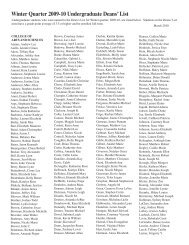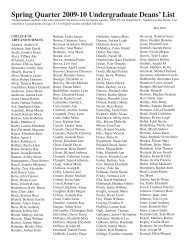Amyotrophic Lateral Sclerosis: An Overview for Pharmacists
Amyotrophic Lateral Sclerosis: An Overview for Pharmacists
Amyotrophic Lateral Sclerosis: An Overview for Pharmacists
Create successful ePaper yourself
Turn your PDF publications into a flip-book with our unique Google optimized e-Paper software.
<strong>Amyotrophic</strong> <strong>Lateral</strong> <strong>Sclerosis</strong>: <strong>An</strong> <strong>Overview</strong> <strong>for</strong> <strong>Pharmacists</strong><br />
<strong>An</strong>drew Skouby, a second-year pharmacy student from Mentor, Ohio; <strong>An</strong>drew M. Roecker,<br />
PharmD, ’00, BCPS, Associate Professor of Pharmacy Practice<br />
This knowledge-based activity is targeted <strong>for</strong> all pharmacists and is acceptable <strong>for</strong> 1.0 hour (0.1<br />
CEU) of continuing education credit. This course requires completion of the program evaluation<br />
and at least a 70 percent grade on the program assessment questions.<br />
ACPE Universal Activity Number 0048-0000-11-032-H01-P<br />
Objectives<br />
After completion of this program, the reader will be able to:<br />
1. Describe and differentiate between the three types of ALS.<br />
2. Describe the process used to diagnose ALS.<br />
3. Explain the perceived mechanism of action <strong>for</strong> riluzole.<br />
4. Discuss the factors thought to have an influence on the pathogenesis of ALS.<br />
5. List several treatment modalities that may improve the quality of life <strong>for</strong> ALS patients.<br />
6. Describe the role of a pharmacist in the life of an ALS patient.<br />
<strong>Overview</strong><br />
<strong>Amyotrophic</strong> lateral sclerosis (ALS) is a progressive neurodegenerative muscular disease<br />
that predominately occurs in the adult population. The disease has also been known as motor<br />
neuron disease, Charcot’s disease, and Lou Gehrig’s disease. 1 Prevalence of ALS is<br />
approximately 20% higher in men than it is in women. 2 ALS is increasing in incidence at a rate<br />
that is faster than can be explained by the aging population. 3 It is estimated that 5600 new cases<br />
of ALS are diagnosed each year in the United States, and that around 30,000 people may have<br />
the disease at any given time. ALS affects between 1.2 and 1.8 per 100,000 individuals.<br />
However, as this number takes into account the entire U.S. population, and ALS is a disease that<br />
most commonly presents later in a patient’s life; this number is heavily skewed when it comes to<br />
overall risk. 2<br />
ALS is one of the more complex and misunderstood diseases that healthcare<br />
professionals may encounter <strong>for</strong> various different reasons: (1) there are multiple different <strong>for</strong>ms<br />
of the disease 3 , (2) the pathogenesis is not fully delineated 1 , (3) diagnosis can occur only by<br />
exclusion, (4) there exists only one FDA approved medication, riluzole, <strong>for</strong> the treatment of<br />
ALS 2 , and (5) there is no cure. Several research designs are currently in progress in order to try<br />
to understand the disease so that it is possible to treat and potentially discover a cure. As the<br />
disease continues to increase in incidence, pharmacists practicing in both a hospital and<br />
community setting are becoming more and more likely to come into contact with patients<br />
plagued by ALS. This article is meant to prepare the pharmacist <strong>for</strong> that proposition by<br />
providing an insight into disease pathogenesis and prognosis, the treatment plans <strong>for</strong> patients<br />
with the disease, and the role that the pharmacist may hold in ALS patients’ lives.
Disease Types<br />
There exist three <strong>for</strong>ms of ALS and each affects the human body in similar, yet distinctly<br />
different ways. Least prevalent, the Western Pacific <strong>for</strong>m of ALS was originally observed in<br />
Guam and the surrounding Trust Territories. 2 Along with possessing the general characteristics<br />
of the disease, to be discussed in the <strong>for</strong>thcoming section, patients with this <strong>for</strong>m of ALS exhibit<br />
an abnormally high incidence of dementia 3 . Fortunately, prevalence of this type of ALS is near<br />
negligible in the United States and is there<strong>for</strong>e beyond the scope of this article.<br />
However, familial ALS (fALS) is more common. The familial <strong>for</strong>m of the disease,<br />
accounting <strong>for</strong> approximately 5-10% of all diagnosed ALS cases 2 , can be inherited from<br />
generation to generation. Because of its obvious link to genetics, fALS is especially intriguing to<br />
researchers. Though there are several genes that cause motor neuron diseases, only three are<br />
directly linked to the ALS phenotype. 3 <strong>An</strong>d though the complete route through which ALS is<br />
transmitted via the genetic material is still not understood, researchers are most interested in one<br />
specific gene whose mutation occurs in somewhere between 20-25% of all fALS patients. The<br />
cytosolic Cu/Zn superoxide dismutase 1 (SOD1) gene is transmitted via an autosomal dominant<br />
route. 3 There<strong>for</strong>e, there is a 50% chance that the mutation will be transmitted to offspring of the<br />
diseased. 1 Specifically a concern <strong>for</strong> fALS, the mean age of onset <strong>for</strong> the disease is 55-65 years<br />
of age. 4 Thus, unin<strong>for</strong>med individuals with an ALS-causing mutation could easily pass the<br />
mutation on to their progeny without any knowledge of the disease that may be present in their<br />
genome.<br />
In contrast to Western Pacific and Familial ALS, Sporadic ALS is the most prevalent<br />
<strong>for</strong>m of the disease in the United States. Sporadic ALS (to be referred to simply as ALS)<br />
accounts <strong>for</strong> 90-95% of newly diagnosed cases in the United States. 2 Patients afflicted with this<br />
subset of the disease are clinically known as typical ALS patients and exhibit the most common<br />
features of the disease. 3<br />
Clinical Signs<br />
ALS clinical signs and symptoms are typically divided into two distinct subtypes: those<br />
of the upper motor neurons and those of the lower motor neurons. Symptoms of upper motor<br />
neuron destruction include, but are not limited to, moderate weakness, loss of dexterity, slowed<br />
movements, spasticity, and hyperreflexia. Symptoms of lower motor neuron destruction include,<br />
but are not limited to, severe weakness, hyporeflexia, muscle atrophy, fasciculations (involuntary<br />
muscle twitches), muscle cramps, and muscle hypotonicity. In addition to these clinical signs,<br />
there are also several neuropathological aspects of the disease, usually associated with loss of<br />
muscle control, and occasionally with cases of dementia. 3<br />
Pathogenesis<br />
The full pathogenesis of ALS is not well understood as it has not been fully elucidated by<br />
medical research. As with other neuromuscular degerative diseases, several key factors can be<br />
noted when it comes to ALS pathogenesis. These factors include: (1) Genetics, (2)<br />
Excitotoxicity, (3) Oxidative stress, (4) Mitochondral dysfunction, (5) Impaired axonal transport,<br />
(6) Neurofilament aggregation, (7) Protein aggregation, (8) Inflammatory dysfuction and<br />
contribution of non-neuronal cells, (9) Deficits of neurotrophic factors and dysfunction of<br />
signalling pathways, and (10) Apoptosis. 1,5<br />
(1) Genetics: As previously mentioned, around 20% of fALS patients and 2% of<br />
sporadic ALS patients present with the SOD1 gene mutation. It is known that there may be as
many as six gene loci that code <strong>for</strong> the ALS phenotype, but only three have been identified.<br />
Several other mutations have also been documented to possibly take part in the pathogenesis of<br />
ALS. Most of the genetics are passed via the autosomal dominant route, though some are<br />
autosomal recessive and others may be sex-linked. 1<br />
(2) Excitotoxicity: Excitotoxicity is a term used to signify the damage undertaken by<br />
neuronal cells that possess overstimulated glutamate receptors, as glutamate is the major<br />
excitatory neurotransmitter in the human central nervous system. 8 As SOD1 codes <strong>for</strong> the major<br />
reuptake protein of glutamate, a mutation limits the concentration levels of that reuptake protein,<br />
allowing an excessive amount of glutamate to be present in the neuronal synapse. It is also<br />
postulated that glutermatergic toxicity plays a direct role in the destruction of neuronal cells in<br />
patients with ALS. 5<br />
(3) Oxidative stress: Oxidative stress is of particular interest to researchers due to the<br />
fact that the SOD1 gene mutation that is known to cause ALS normally codes <strong>for</strong> an anti-oxidant<br />
protein. 8 Post-mortem studies of ALS victims have shown that diseased cells show a higher<br />
sensitivity to radicalization than those of a control. Also, free radical tissue damage is an<br />
accepted and acknowleged symptom of ALS. 1<br />
(4) Mitochondrial dysfunction: There are many new data that have come to support<br />
the theory that mitochondrial dysfunction plays a large role in the pathogenesis of ALS.<br />
Multiple cases of dysfunctional mitochondria have been noted in post-mortem analyses of ALS<br />
patients. 1 Dysfunctional mitochondria have also been linked to the SOD1 gene mutation in mice<br />
models. 5<br />
(5) Impaired axonal transport: The theory that axonal transport is key to ALS<br />
pathogenesis stems from SOD1 transgenic mice models. Mice from these models often show<br />
slowed anterograde and retrograde axonal transport. No human ALS patient has yet to present<br />
with this problem, yet it is known to occur in several other neuromuscular disorders of the<br />
human body. 1<br />
(6) Neurofilament aggregation: Abnormal neuronal assembly, including those with<br />
accumulation of neurofilaments, are often seen in ALS patients. Neurofilaments can combine<br />
with a toxic <strong>for</strong>m of peripherin, an intermediate filament protein, and be toxic to neurons even at<br />
modest concentration levels. This combination has been found in the spinal cord of ALS patients<br />
and not in controls. This evidence points to neurofilament aggregation as being a part of ALS<br />
pathogenesis. 1<br />
(7) Protein aggregation: Long debates as to whether protein aggregation take a part in<br />
disease pathogenesis have been had. It is possible that these inclusions may simply be innocent<br />
bystanders, or even beneficial to the cells. 1 In mutant SOD1 transgenic mice models, protein<br />
inclusion bodies are seen in most neurons of the afflicted mice, making it possible that protein<br />
aggregation exists as a part of ALS pathogenesis. Several theories have been put <strong>for</strong>th as to how<br />
protein inclusions in neurons may lead to cell toxicity, but nothing has yet been confirmed. 5<br />
(8) Inflammatory dysfunction and contribution of non-neuronal cells: It has been<br />
recently discovered that SOD1 mutations alone are insufficient to cause ALS in transgenic mice,<br />
making the case that non-neuronal cells may play a part in ALS pathogenesis. 5 ALS patients<br />
commonly experience activation of the non-neuronal microglial and dendritic cells. This<br />
activation has been shown to produce inflammatory cytokines such as interleukins and tumor<br />
necrosis factor (TNF). However, recent trials have yet to see success in utilizing<br />
immunomodulatory drug therapies to curve the progression of ALS. 1
(9) Deficits of neurotrophic factors and dysfunction of signalling pathways:<br />
Lowered levels of neurotrophic factors have been noticed in post-mortem analysis of several<br />
ALS patients. In addition, three mutations in the Vascular Endothelial Growth Factor (VEGF)<br />
gene were thought to be associated with an increased risk <strong>for</strong> developing ALS. However,<br />
recently these finding have come under scrutiny due to an inability to replicate research results. 1<br />
(10) Apoptosis: Current research also skews towards examining if ALS motor neuron<br />
destruction occurs via a cell programmed death, or apoptosis. Several studies have shown that<br />
cell death due to ALS often occurs because of this programmed apoptosis, yet these findings are<br />
still being reviewed and discussed heavily. 5<br />
Diagnosis<br />
The diagnosis of ALS in a patient is not an easy one to come to, and the time that passes<br />
between symptom onset and diagnosis is often up to an entire year. 6,7 Because of the noted lack<br />
of understanding in the pathogenesis of ALS, the diagnosis is done almost purely by excluding<br />
other neurodegenerative disorders. The El Escorial diagnostic criteria are the most commonly<br />
accepted <strong>for</strong> the diagnosis of ALS. Using these criteria, ALS is diagnosed if the following<br />
conditions are met:<br />
A: the presence of the following:<br />
1. Evidence of lower motor neuron (LMN) degeneration,<br />
2. Evidence of upper motor neuron (UMN) degenration, and<br />
3. Continuing spread of symptoms within one body region to other body regions, and<br />
B: the absence of the following:<br />
1. <strong>An</strong>y kind of pathological evidence of a disease state that may account <strong>for</strong> the LMN or<br />
UMN degeneration, and<br />
2. Neuroimaging evidence that may explain any of the experienced symptoms 7<br />
It is because of these complex requirements that ALS often goes so long be<strong>for</strong>e being<br />
diagnosed. ALS diagnoses are there<strong>for</strong>e classified into six separate “El Escorial” categories: (1)<br />
suspected ALS, (2) possible ALS, (3) probable ALS, (4) probable (laboratory supported) ALS,<br />
(5) definite fALS, and (6) definite ALS. The main factor that allows a patient to move through<br />
the ranks from suspected ALS to definite ALS is simply time to allow the symptoms to progress<br />
and become more defining. fALS becomes definite if signs and symptoms exist in the presence<br />
of the SOD1 gene mutation discussed above. 3,7<br />
Riluzole<br />
There exists only a single FDA approved medication <strong>for</strong> the treatment of ALS. The drug<br />
is called Riluzole, has a brand name of Rilutek®, and is manufactured by Rhone Poulenc Rorer<br />
Pharmaceutical Inc. The medication comes in the single dose of a 50 mg tablet. The drug<br />
maintains the lone indication of aiding the prognosis of patients with ALS by extending survival<br />
time or extending the time until a tracheostomy is required. The tablet is to be taken at the same<br />
times each day once every 12 hours, at least an hour be<strong>for</strong>e, or two after meals in order to<br />
decrease the likelihood of a food-decreased bioavailability.
As noted above, the pathogenesis of ALS is not fully delineated. It is there<strong>for</strong>e not<br />
surprising that the mode of action <strong>for</strong> riluzole is also not fully understood. Although the reason<br />
<strong>for</strong> the effects on ALS prognosis are not clear, riluzole exerts the following pharmacologic<br />
effects:<br />
1. <strong>An</strong> inhibitory effect on glutamate release<br />
2. Inactivation of voltage-dependent sodium channels<br />
3. Ability to interfere with intracellular events that follow transmitter binding at excitatory<br />
amino acid receptors 8<br />
It is commonly thought that the ability to inhibit the effect of glutamate release has the strongest<br />
effect on ALS pathogenesis. It has been hypothesized that in ALS, glutamate concentrates in the<br />
synapses of motor neurons and causes them to die. 9 In rat-tested animal trials, riluzole protected<br />
rat motor neurons from the excitatory effects of glutamic acid and prevented the death of cortical<br />
neurons. 8 Recent studies indicate that riluzole will prolong median survival rates by anywhere<br />
from two to three months 4 , and has a 9% chance to increase lifespan by a full year. 6 The drug is<br />
usually well tolerated, and the most common side effects include asthenia, nausea,<br />
gastrointestinal tract upset, and abnormal liver function tests. There<strong>for</strong>e, liver function should be<br />
monitored at baseline and at regular intervals while taking riluzole.<br />
Pharmacokinetics of Riluzole<br />
Absorbtion/Distribution<br />
Riluzole is absorbed well from the gastrointestinal tract with approximately 90%<br />
absorption with absolute bioavailability of the medication at roughly 60%. This absorption is<br />
adversely affected when taken with a high-fat meal as area under the curve (AUC) decreases by<br />
20% with corresponding peak blood levels of riluzole decreased by 45%. This strengthens the<br />
need <strong>for</strong> appropriate patient education on timing of riluzole administration to provide more<br />
consistent levels of the medication. Riluzole is highly protein bound (96%) to albumin and<br />
lipoproteins which allow <strong>for</strong> wide distribution including areas of the central nervous system. 8,10<br />
Metabolism / Excretion:<br />
Metabolism of riluzole is dependent on cytochrome P450 1A2 (CYP1A2) activity and is<br />
entirely hepatic in activity. CYP1A2 is responsible <strong>for</strong> hydroxylation and glucuronidation of<br />
riluzole to 6 major metabolites and several minor metabolites. There is little evidence that other<br />
CYP enzymes are involved in the metabolism of this medication. Potential drug interactions<br />
could occur with activitites/medications that either induce (smoking) or inhibit (fluvoxamine or<br />
fluoroquinolone antibiotics) CYP1A2 and should be closely monitored <strong>for</strong>. There are also a<br />
number of CYP1A2 polymorphisms that help explain interpatient variability with riluzole<br />
metabolism. It is important to monitor closely <strong>for</strong> signs of adverse reactions upon initiation of<br />
therapy with riluzole. 8-10<br />
The mean elimination half-life of riluzole is 12 hours with 90% excreted in urine. Most<br />
is eliminated as glucuronidated metabolites (85%) with only 2% eliminated as unchanged drug.<br />
Only 5% of riluzole is excreted in feces. During clinical trials, there was still evidence of<br />
riluzole elimination up to 7 days following initial dosing with this effect explained by slow direct<br />
glucuronidation of riluzole in humans. 8-10
Symptomatic Treatment<br />
As riluzole is the only approved treatment of ALS, several ancillary treatments are<br />
necessary to relieve ALS symptomatology, in an ef<strong>for</strong>t to improve patient quality of life. As<br />
such, it has been noted that patients who seek relief from multidisciplinary healthcare settings<br />
see, on average, a 7.5 month increase in lifespan compared to those who strictly seek relief from<br />
a neurology clinic. 6<br />
Symptom management and ancillary treatment aimed at symptomatology was found to be<br />
increasingly beneficial. 1 The following figure presents several symptoms of ALS and provides<br />
possibilities <strong>for</strong> both pharmacologic and non-pharmacologic approaches to reduce the negative<br />
effects of these symptoms.<br />
Symptom 1,8-10 Treatment (Pharmacologic) Treatment (Nonpharmacologic)<br />
Muscle Cramping<br />
• carbamazepine: commonly<br />
used as anti-seizure medication,<br />
• physiotherapy<br />
has muscle relaxant and<br />
anticholergenic properties<br />
• phenytoin: commonly used as<br />
• physical exercise<br />
• massage<br />
anti-convulsant and works by<br />
directly interacting with sodium<br />
ion pumps in the motor cortex<br />
• hydrotherapy<br />
Muscle Spasticity<br />
Excess/Watery Saliva<br />
• quinine sulfate: proposed as an<br />
incredibly effective treatment,<br />
however the FDA has recently<br />
warned against its use against<br />
cramping symptoms<br />
• baclofen: has labeled<br />
indication <strong>for</strong> reversible<br />
spasticity by inhibiting the<br />
synaptic reflexes at the spinal<br />
cord level<br />
• tizanidine: has labeled<br />
indication <strong>for</strong> muscle spasticity<br />
by decreasing excitatory input to<br />
alpha motor neurons<br />
• dantrolene: has labeled<br />
indication <strong>for</strong> spasticity<br />
associated with UMN disorders<br />
by interfering with calcium ion<br />
channels<br />
• atropine: labeled indication <strong>for</strong><br />
inhibiting salivary secretions by<br />
blocking the action of<br />
acetylcholine in secretory glands,<br />
and by drying salivary secretions<br />
• physiotherapy<br />
• hydrotherapy<br />
• cryotherapy<br />
• home suction device<br />
• drinking dark grape juice<br />
• using sugar-free citrus lozenges
Pain<br />
• hyoscine drugs: labeled<br />
indication to decrease salivary<br />
secretions by blocking the action<br />
of acetylcholine in secretory<br />
glands and by drying secretions<br />
• glycopyrrolate: labeled<br />
indication to inhibit salivation<br />
and excessive secretions by<br />
blocking the action of<br />
acetylcholine in secretory glands<br />
• amitriptyline: labeled<br />
indication is <strong>for</strong> depression, yet is<br />
occasionally used <strong>for</strong> excessively<br />
watery saliva<br />
• propranolol: labeled indication<br />
is <strong>for</strong> management of<br />
hypertension, yet is occasionally<br />
used to control persistent salivary<br />
secretions<br />
• metoprolol: labeled indication<br />
<strong>for</strong> management of hypertension,<br />
yet is occasionally used to<br />
control persistent salivary<br />
secretions<br />
• analgesics<br />
• NSAIDs<br />
• opioids<br />
• nebulization<br />
• steam inhalation<br />
• injections of botulinum toxin<br />
into the parotid glands<br />
• irradiation of the salivary<br />
glands<br />
• use of an assisted cough<br />
insufflator-exsufflator<br />
• rehydration with jelly or ice<br />
• drinking pineapple or papaya<br />
juice<br />
• reduced intake of dairy<br />
products, alcohol, and caffeine<br />
• offering com<strong>for</strong>t<br />
In addition to the symptoms listed in the above table, some patients present with<br />
excessive or violent yawning. These patients may find relief by taking baclofen. For<br />
laryngospasms, patients should take lorazepam. Also, patients may experience constipation, <strong>for</strong><br />
which lactulose or senna with hydration and increased fiber intake should help with this<br />
symptom. 1<br />
Malnutrition is commonly seen in ALS patients due to the myriad of ALS-associated<br />
symptoms contributing to the etiology. The health care team needs to be wary of the possibility<br />
that the patient will stop eating certain foods due to a difficulty of swallowing or constipation.<br />
Dieticians should be consulted in order to ensure that correct fluid consistancy of food is utilized<br />
in order to aid in proper nutrition <strong>for</strong> patients. 6<br />
Depression, anxiety, insomnia and fatigue are other common symptoms that ALS patients<br />
are <strong>for</strong>ced to deal with. Common prescription and over-the-counter medications that are utilized<br />
<strong>for</strong> these symptoms can be prescribed and dispensed to the ALS patient. In addition to these<br />
medications, non-pharmacologic treatments such as phychological support, counseling, and<br />
com<strong>for</strong>t should be provided to patients experiencing these symptoms.<br />
In addition to physical symptoms, the emotional stress of having difficulties<br />
communicating often takes its toll on patients. Possible treatments <strong>for</strong> symptoms such as this<br />
include: learning new speaking techniques, low-tech augmentative and alternative
communication tools, voice amplifiers, light writers, scanning systems operated by switches, and<br />
brain-computer interfaces. Some of these solutions are only <strong>for</strong> very rare cases. It is important<br />
that, when confronted with an ALS patient, a pharmacist be empathetic to the patient’s individual<br />
disease characteristics and how he/she may work to help relieve that symptomatology. 1<br />
Prognosis<br />
Large patient samples of those diagnosed with ALS consistantly show a median survival<br />
time of somewhere between 2-5 years, depending on the location and onset of symptoms. For<br />
those experiencing bulbar onset ALS (whose symptoms begin in the brainstem), the median<br />
survival time is 2-3 years, and <strong>for</strong> those experienceing limb onset ALS the median survival time<br />
is 3-5 years. Only around 4% of patients will live 10 years from the onset of symptoms.<br />
However, some population based studies note that a 5 year survival rate may actually be as low<br />
as 4%. 1<br />
As previously noted, treatment of ALS with riluzole may extend life (or time until<br />
tracheostomy) by around 2-3 months. In addition to riluzole use, other indicators of survival<br />
time include: site of symptom onset, age of symptom onset, time between symptom onset and<br />
diagnosis, and El Escorial category at presentation. 1<br />
Current Research<br />
As noted several times over, both pathogenesis and treatment of ALS are not understood<br />
to an adequate degree. Thus far, the scientific community has merely been able to make<br />
educated guesses as to the causes of ALS and, there<strong>for</strong>e, how to treat the disease state. ALS is a<br />
hotbed <strong>for</strong> research due to the devastating effects that it has on the human body and the lack of<br />
in<strong>for</strong>mation that currently exists. Several recent and/or current studies are evaluating different<br />
perspectives in the overall treatment and outcomes of ALS.<br />
In early 2009, there were several clinical trials that were in the midst of being conducted.<br />
There were four separate Phase I studies, eight Phase II studies, and four Phase III studies. 6<br />
These tests have all yet to publish any data or conclusive findings relating to an improvement in<br />
the current treatment modalities used in ALS patients today.<br />
To diverge from unpublished data, one recent research model worked off of the body of<br />
evidence emerging that hypothesized that lithium carbonate was successful in significantly<br />
slowing the progression of ALS. This evidence emerged from a trial treating solely male<br />
transgenic mice models that concluded that lithium carbonate was effective at increasing lifespan<br />
in male mice. A research model was then crafted to attempt to universalize this treatment to<br />
several mice models that included only female subjects. The mice in this model were treated<br />
with lithium carbonate 37 mg/kg in an ef<strong>for</strong>t to prolong lifespan. The conclusion of the study<br />
was that lithium carbonate presented no positive therapeutic effects in female SOD1 transgenic<br />
mice. 11 The researchers were unable to exclude gender as the factor that prevented the results<br />
from the earlier trial from being replicated. However, it is well known that SOD1 transgenic<br />
mice show gender differences in terms of disease progression and lifespan, and that there are<br />
noted treatments that will work <strong>for</strong> one gender, but not the other. 11<br />
In addition to the above trials, several other pharmacologic agents have been tested <strong>for</strong><br />
effect on the progression of ALS. In transgenic mice models, treatment with thalidomide or<br />
lenalidomide enhanced motor neuron per<strong>for</strong>mance and elongated lifespan. In the human clinical<br />
trial, thalidomide was given to patients at a dose of up to 400 mg/day as was suggested <strong>for</strong> use in<br />
other neurodegenerative diseases. The conclusion of the study failed to note any positive effects
produced by thalidomide in terms of disease progression or prolonged survival, and actually<br />
noticed several negative side effects associated with thalidomide treatment, including<br />
constipation, fatigue, neuropathy, and rash development. Researches note that, as lenalidomide<br />
is a more potent analog and has a different side-effect profile, may be more effective as an ALS<br />
treatment in humans. 12<br />
Thinking in a different manner, Garvey et al. conducted a survey in order to determine<br />
how the use of total laryngectomies (TL) were being used as symptomatic treatment <strong>for</strong> bulbar<br />
dysfunction in ALS patients. The study concluded that TL are a relatively safe and effective<br />
symptomatic treatment <strong>for</strong> ALS patients to seek out when that have severe bulbar dysfunction. 13<br />
Additionally, more positive news coming out of recent research is the Qureshi et al. hypothesis<br />
that ALS survival rates in placebo clinical trial groups have been steadily increasing over time<br />
since 1990. The main reason that the authors propose <strong>for</strong> this noted statistic is simply improved<br />
symptomatic care of the ALS patient population. 14<br />
The regulation and control of ALS symptoms is one specific arena that the pharmacist in<br />
particular can participate heavily in. The pharmacist is commonly noted as the most accessible<br />
health-care professional, and this is especially important to terminal patients, as symptomatic<br />
control is all that they can hope to acheive.<br />
Pharmacist’s Place<br />
At the culmination of every pharmacist’s education, he/she takes an oath that includes a<br />
vow to place the welfare of humanity and the relief of suffering at the top of his/her priorities. It<br />
is with this goal that a pharmacist must approach being a part of the treatment of a terminal<br />
patient.<br />
In the case of ALS patients, the pharmacist is likely to be most involved at the terminal<br />
portion of the disease. At this point in their lives, patients will be experiencing many of the<br />
symptoms noted above and will be seeking relief. The pharmacist can make it his/her objective<br />
to aid these individuals by providing them with a means to be com<strong>for</strong>table in the end stages of<br />
their lives.<br />
In their article, “Coping with Terminal Illness,” Dr. Guido Zanni and Dr. Charles Browne<br />
cite the fact that different patients will want differing amounts of in<strong>for</strong>mation depending on their<br />
individual symptoms. 15 They also believe that pharmacists hold a key role in helping patients to<br />
cope with their symptoms and their fate.<br />
First off, pharmacists need to engage in an active partnership with their patients. They<br />
need to explain options and symptomatic treatments both clearly, and in a way that an elderly<br />
individual will be able to understand. <strong>Pharmacists</strong> are experienced in this type of activity, and<br />
need to be sure to be especially diligent in providing in<strong>for</strong>mation to terminal patients.<br />
Also, it has been shown that terminal patients prefer to be told in<strong>for</strong>mation in person and<br />
not over the phone. As pharmacy becomes increasingly pace-motivated, especially in the retail<br />
sector, it is critical that pharmacists still allocate time to face-to-face patient counseling.<br />
Terminal patients in particular desire this one-on-one counseling time in order to ensure that they<br />
are doing all that they possibly can in order to alleviate their symptoms.<br />
In addition, ALS patients are extremely interested in symptomatic progression and how it<br />
is going to be dealt with. It is true that a physician will undoubtedly discuss possible symptoms<br />
with the patient, but Zanni notes that patients only recall around 50% of the in<strong>for</strong>mation<br />
presented to them by their physicians. There<strong>for</strong>e, it is critical that the pharmacist be able to<br />
explain current and progressive symptoms, as well as treatment options to an ALS patient.
To further extrapolate on the specific role of the pharmacist, it has been shown over and<br />
over that a patients understanding of their situation directly impacts patient outcomes. Patients<br />
lacking full knowledge of their conditions are at an increased risk <strong>for</strong> inadequate management of<br />
end of life care, unnecessary hospitalizations, and (especially relevant to the pharmacist) poorer<br />
symptomatic control. 15<br />
It is the unique opportunity of the pharmacist to be able to help ALS patients with<br />
specific symptoms that they experience. Many of the symptoms that ALS patients experience<br />
are able to be managed with appropriate use of over the counter (OTC) medication and nonpharmacologic<br />
intervention. It is also highly likely that new symptoms will arise without the<br />
patient seeking out new prescriptions from his/her physician. It is the pharmacist’s place to<br />
initiate patient-physician contact in order to facilitate the patients’ procurement of adequate and<br />
satisfactory symptomatic management.<br />
In addition to ensuring that the patient is receiving all necessary medications and<br />
treatments, it is also the role of the pharmacist to take note of any possible side effects that are<br />
being experienced. Asking open-ended questions about possible side effects will allow the<br />
pharmacist to determine whether these adverse symptoms are simply symptoms of the disease<br />
itself or true side effects from symptomatic treatment, as the two are easily confused by the<br />
patient.<br />
Additionally, a pharmacist must ensure that meetings with terminal patients occur in<br />
appropriate meeting areas. Patients need to feel com<strong>for</strong>table and that their right to privacy will<br />
not be broken. True insight into the lives of the patient will not be had unless the patient feels<br />
com<strong>for</strong>table discussing their condition. There<strong>for</strong>e, it is critical that the pharmacist maintain a<br />
positive relationship with the patients that he/she serves on a daily basis. 15<br />
Similarly, most research stipulates that health care professionals must avoid being too<br />
pessimistic in initial discussion about terminal illness. 16 By the time an ALS patient comes into<br />
the pharmacy, they will know the general characteristics of the disease. However, it is still<br />
critical to assume a stance of positivity when it comes to symptomatic treatment. Be sure to be<br />
truthful and realistic when it comes to symptom management, but never intimidating or overly<br />
morbid.<br />
It is the duty of a pharmacist to serve the public. ALS patients represent a very unique<br />
subset of the American population, yet one that is un<strong>for</strong>tunately growing in prevalence every<br />
year. This article is meant to give the pharmacist an insight into the condition, and provide a<br />
means <strong>for</strong> one to understand how it causes damage, what this damage means <strong>for</strong> a patient, and<br />
the best way to provide <strong>for</strong> these patients as a pharmacist.
References<br />
1. Wijesekera LC and Leigh PN. <strong>Amyotrophic</strong> lateral sclerosis. Orphanet Journal of Rare Diseases 2009<br />
[cited 2011 Feb 17]; 4(3) [about 22 p.]. Available from:<br />
http://www.ojrd.com/content/4/1/3<br />
2. The ALS Association. Washington, D.C.: The ALS Association; c2007 [updated 2008 Oct; cited 2011<br />
Feb 17]. Available from http://www.alsa.org/.<br />
3. Strong M and Rosenfeld J. <strong>Amyotrophic</strong> lateral sclerosis: a review of current concepts. ALS and other<br />
motor neuron disorders 2003; 4: 136-143.<br />
4. Pasinelli P and Brown RH. Molecular biology of amyotrophic lateral sclerosis: insights from genetics.<br />
Nature reviews neuroscience 2006 September; 7: 710-723.<br />
5. Shaw PJ. Molecular and cellular pathways of neurodegeneration in motor neurone disease. J Neurol<br />
Neurosurg Psychiatry 2005; 76: 1046-1057.<br />
6. Phukan J and Hardiman O. The management of amyotrophic lateral sclerosis. J Neurol 2009; 256:<br />
176-186.<br />
7. World Federation of Neurology [homepage on the internet]. World Federation of Neurology; c1997-<br />
2006 [updated 2006 Sep 2; cited 2011 Feb 19]. Revised Criteria <strong>for</strong> the Diagnosis of <strong>Amyotrophic</strong> <strong>Lateral</strong><br />
<strong>Sclerosis</strong>; [about 8 screens]. Available from:<br />
http://web.archive.org/web/20070517041851/http://www.wfnals.org/guidelines/1998elescorial/elescorial1<br />
998criteria.htm#clinevidence.<br />
8. Riluzole monograph. Facts and comparisons online. [cited 2011 Feb 19] Available at:<br />
http://online.factsandcomparisons.com<br />
9. Riluzole monograph. Clinical pharmacology online. [cited 2011 Feb 19] Available at:<br />
http://www.clinicalpharmacology-ip.com<br />
10. Lacy CF, Armstrong LL, Goldman MP, Lance LL. Lexi-Drugs – Comprehensive and Specialty<br />
Fields. Hudson OH; Lexi-comp, Inc: 2011.<br />
11. Pizzasegola C, Caron I, Daleno C, Ronchi A, Minoia C, Carrí MT, et al. Treatment with lithium<br />
carbonate does not improve disease progression in two different strains of SOD1 mutant mice.<br />
<strong>Amyotrophic</strong> <strong>Lateral</strong> <strong>Sclerosis</strong> 2009; 10: 221-228.<br />
12. Stommel EW, Cohen JA, Fadul CE, Cogbill CH, Graber DJ, Kingman L, et al. Efficacy of<br />
thalidomide <strong>for</strong> the treatment of amyotrophic lateral sclerosis: a phase II open label clinical trial.<br />
<strong>Amyotrophic</strong> <strong>Lateral</strong> <strong>Sclerosis</strong> 2009; 10: 393-404.<br />
13. Garvey CM, Boylan KB, Salassa JR, and Kennelly KD. Total laryngectomy in patients with<br />
adavanced bulbar symptoms of amyotrophic lateral sclerosis. <strong>Amyotrophic</strong> <strong>Lateral</strong> <strong>Sclerosis</strong> 2009; 10:<br />
470-475.<br />
14. Qureshi M, Schoenfeld DA, Paliwal Y, Shui A, and Cudkowicz ME. The natural history of ALS is<br />
changing: improved survival. <strong>Amyotrophic</strong> <strong>Lateral</strong> <strong>Sclerosis</strong> 2009; 10: 324-331.<br />
15. Zanni GR, Browne CL. Coping with terminal illness. Pharmacy Times online; 2010 Aug 17. [cited<br />
2011 Feb 19] Available at:<br />
http://www.pharmacytimes.com/publications/issue/2010/August2010/CounselingTerminalIllness-0810<br />
16. Borasio GD, Sloan R, and Pongratz DE. Breaking the news in amyotrophic lateral sclerosis. J Neurol<br />
Sci 1998 Oct; 160 (Supp. 1): S127-S133.


